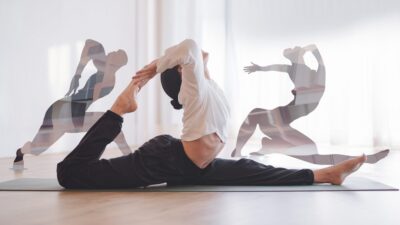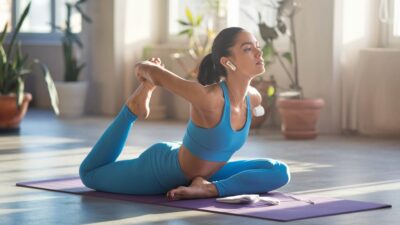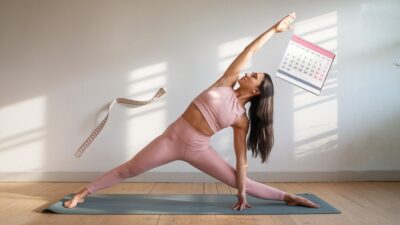A well-rounded flexibility routine is essential for your athletic performance and injury prevention. You'll want to start with dynamic stretches before workouts, including arm circles, walking lunges, and leg swings for 8-10 minutes. After training, focus on static stretches within 15 minutes of finishing, holding each position for 15-30 seconds. Don't forget to target major muscle groups like hamstrings, quadriceps, and hip flexors while maintaining steady breathing. Your sport may require specific stretches, so runners might emphasize hip mobility while swimmers focus on shoulders. Understanding proper technique and avoiding common mistakes will take your flexibility training to the next level.
Why Athletes Need Flexibility Training
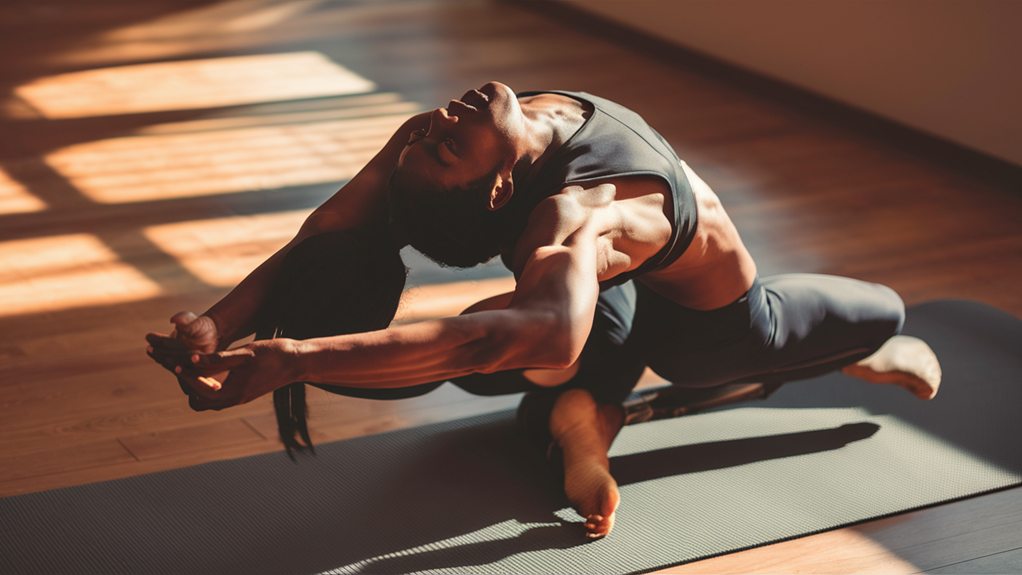
Stretching and maintaining flexibility play an important role in athletic performance and injury prevention. When you're following flexibility routines for athletes, you're actually preparing your body to perform at its highest potential while reducing the risk of muscle strains and tears.
Your muscles, tendons, and ligaments need regular attention to stay pliable and responsive during intense physical activity, as they can greatly enhance your overall performance and longevity in sports. Unlocking fitness involves understanding how flexibility and mobility contribute to your athletic capabilities.
Stretching for sports performance isn't just about touching your toes before practice; it's about developing a thorough approach to mobility that supports your specific athletic demands.
You'll find that flexibility training for athletic performance helps improve your range of motion, which directly impacts your ability to execute movements with proper form and technique.
Whether you're a sprinter needing loose hamstrings, a gymnast requiring exceptional joint mobility, or a basketball player wanting better agility, proper flexibility training is vital.
Pre-Workout Dynamic Stretching Routine
Beginning your workout with dynamic stretches primes your muscles and joints for peak performance. As an integral part of mobility work for athletes, dynamic stretching involves moving parts of your body through a full range of motion, helping you prepare for the demands of your sport or training session. Engaging in these movements not only enhances flexibility but also contributes to stress relief and improved flexibility, which are vital for overall athletic performance.
Start with large, controlled arm circles, both forward and backward, to warm up your shoulder joints and upper body. Next, perform walking lunges with a twist, which activates your legs while engaging your core and improving hip mobility.
You'll want to include leg swings, both front-to-back and side-to-side, to open up your hip flexors and prepare your lower body. Follow this with high knees and butt kicks, moving forward for about 20 yards each, to increase blood flow to your leg muscles.
Don't forget to include torso twists while walking, ankle rotations, and gentle neck rolls to make certain you're addressing all major joint areas. Your dynamic stretching routine should last 8-10 minutes, with each movement performed for 30 seconds or across a specified distance.
Remember to keep your movements controlled and deliberate throughout the routine.
Post-Game Recovery Stretches
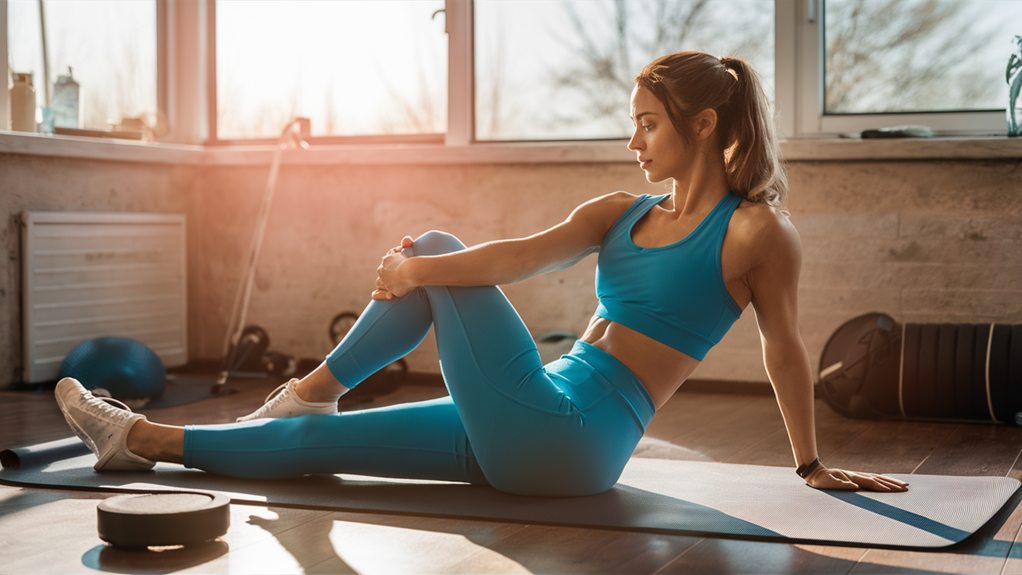
Athletes require a thorough cool-down routine after intense competition or practice to promote recovery and prevent muscle soreness. Incorporating effective stretching techniques can greatly enhance this recovery process and help avoid injuries in the future, as outlined in injury prevention strategies.
You'll want to start your post-game stretching within 15 minutes of finishing activity, when your muscles are still warm and pliable. Begin with gentle walking or light jogging for 3-5 minutes to gradually lower your heart rate and body temperature.
Focus on holding each stretch for 30-45 seconds, and don't forget to breathe deeply throughout the routine. Start with your calves, hamstrings, and quadriceps, as these large muscle groups often experience the most tension during play.
Next, move to your hips, lower back, and glutes, using gentle stretches that don't force or strain your muscles. You'll want to include your upper body too, especially your shoulders, chest, and neck, which can become tight from physical activity.
If you're experiencing particular tightness in certain areas, spend extra time on those spots, but don't overdo it. Remember to stay hydrated during your stretching routine, and listen to your body's signals to avoid overstretching tired muscles.
Joint Mobility Exercises
Maintaining healthy joint mobility is essential for peak athletic performance and injury prevention. Your joints need consistent attention through specific exercises that'll help them move freely through their full range of motion. When you focus on joint mobility, you're not just preventing stiffness but also building a foundation for better overall movement patterns.
It's vital to incorporate safety advice when performing these exercises to avoid injury and maximize effectiveness.
Start your joint mobility routine with gentle arm circles, moving both forwards and backwards, to warm up your shoulder joints. Next, you'll want to rotate your wrists and ankles in circular motions, making sure to move slowly and deliberately through each rotation.
Hip circles are particularly important, as they'll help loosen up one of your body's largest joint complexes. Don't forget about your neck – perform careful tilts and rotations to maintain flexibility in your cervical spine.
For your knees and elbows, try controlled bending and straightening exercises, being mindful not to overextend. These movements should be smooth and pain-free, and you'll want to perform them daily, especially before intense training sessions.
Sport-Specific Flexibility Programs
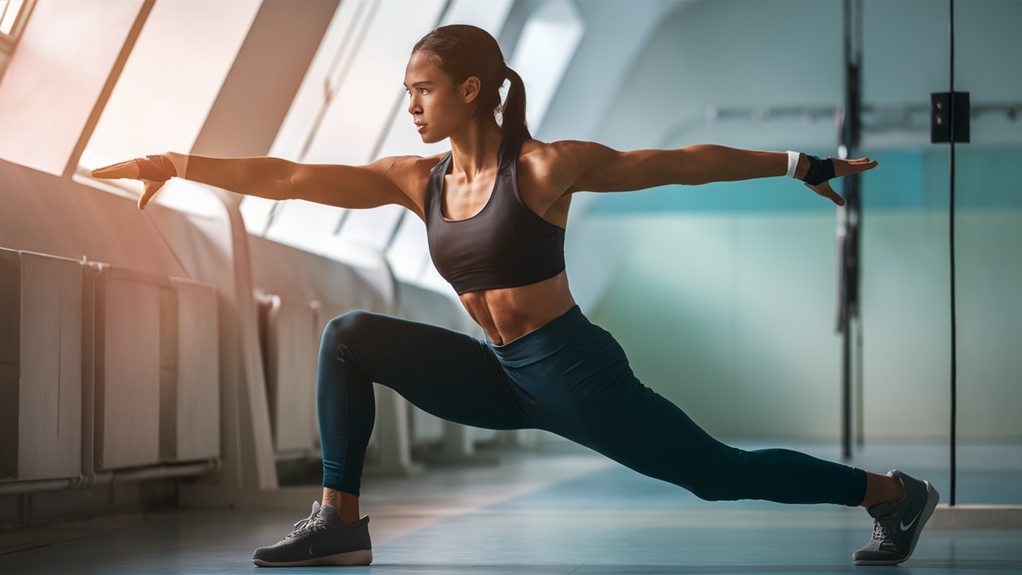
Sport-Specific Flexibility Programs
Every sport demands its own unique set of flexibility requirements, and your stretching routine should reflect these specific needs. When you're planning your flexibility program, you'll want to focus on the muscle groups and movements that are most important for your particular sport. Incorporating elements from empowering seniors through tailored fitness can also provide insights on how to adapt routines for various fitness levels, ensuring a well-rounded approach.
As a swimmer, you'll need to emphasize shoulder and ankle flexibility, while runners should concentrate on hip flexors and hamstrings. Basketball players, you'll want to work on hip mobility and calf flexibility, which are vital for jumping and quick direction changes. If you're a gymnast, full-body flexibility is essential, with special attention to your back, hips, and shoulders.
To create your sport-specific program, start by analyzing the movements you perform most often in your sport. You'll need to identify which joints and muscles are under the most stress during practice and competition.
Then, develop a routine that includes both dynamic stretches for warm-ups and static stretches for cool-downs. Remember to spend extra time on areas that are tight or prone to injury in your sport, and don't forget to work on both sides of your body equally.
Common Stretching Mistakes
Despite good intentions, many people fall into common stretching traps that can limit their progress or even lead to injury. When you're keen to increase your flexibility, you'll want to avoid these frequent mistakes that can set you back in your training. Understanding the distinction between flexibility and mobility is vital for optimizing your routines, as each plays a unique role in your overall physical health and performance how each contributes to performance.
One of the biggest errors you'll encounter is bouncing during stretches, which can cause muscle tears and strains. Instead, you'll want to ease into each position slowly and hold it steadily.
Another mistake you're likely making is rushing through your stretches, when you should be holding each position for at least 15-30 seconds. You're also probably stretching cold muscles, which isn't ideal – always warm up with light cardio first.
If you're feeling pain during stretching, you're pushing too hard. While you should feel tension, sharp pain means you've gone too far.
Additionally, you might be forgetting to breathe properly, which can increase muscle tension. Remember to maintain steady, deep breaths throughout each stretch.

